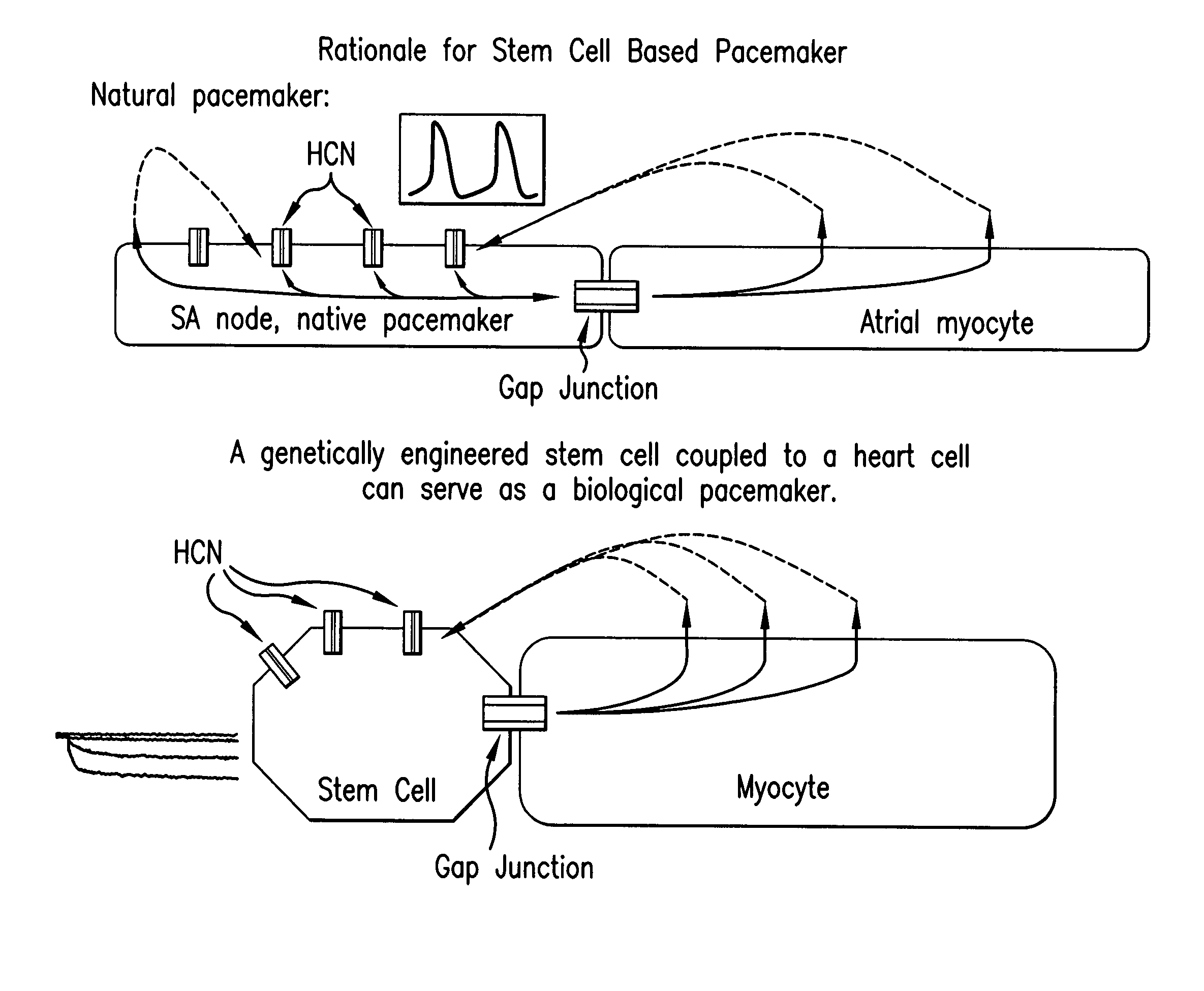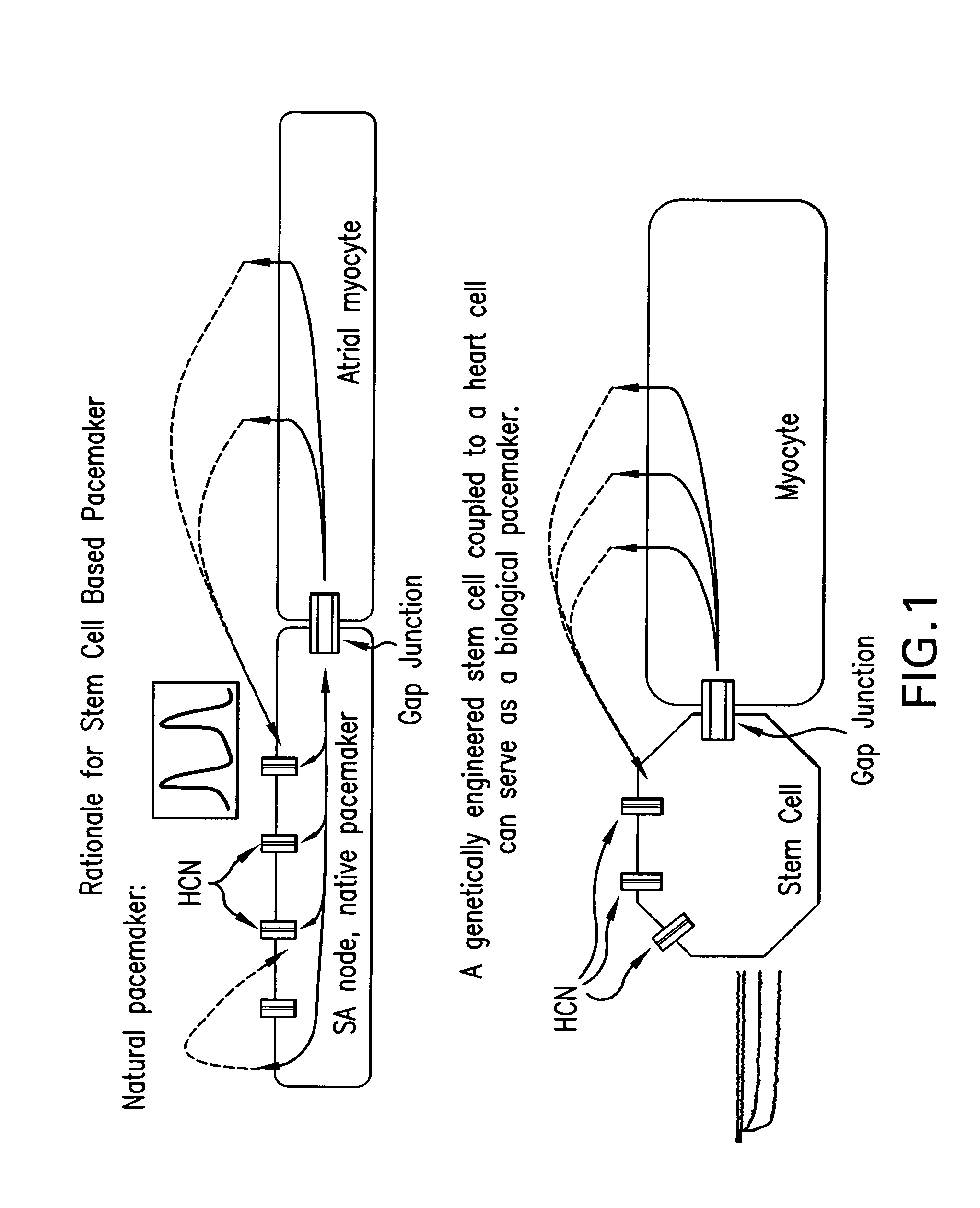Tandem cardiac pacemaker system
a pacemaker and tandem technology, applied in the direction of genetically modified cells, skeletal/connective tissue cells, therapy, etc., can solve the problems of ventricular arrest and/or fibrillation, death, compromising cardiac output, and increasing the risk of heart failure, so as to achieve less negative maximum diastolic potential and higher basal signal frequency
- Summary
- Abstract
- Description
- Claims
- Application Information
AI Technical Summary
Benefits of technology
Problems solved by technology
Method used
Image
Examples
example 1
Expression and Electrophysiological Characterization of HCN Channels in Cultured Cells
[0165]Isolation and Culture of Cardiomyocytes and Xenopus laevis Oocytes
[0166]Adult rats were anesthetized with ketamine-xylazine before cardiectomy, and neonatal rats decapitated. Newborn rat ventricular myocyte cultures were prepared as previously described (Protas and Robinson, 1999). Briefly, 1-2-day-old Wistar rats were euthanized, hearts were quickly removed and ventricles were dissociated using a standard trypsinization procedure. Myocytes were harvested, preplated to reduce fibroblast proliferation, cultured initially in serum-containing medium (except when being transfected with plasmids as described below), and then incubated in serum free medium (SFM) at 37° C., 5% CO2 after 24 h. Action potential studies were conducted on 4-day-old monolayer cultures plated directly onto fibronectin-coated 9×22 mm glass coverslips. For voltage clamp experiments, 4-6 day old monolayer cultures were resus...
example 2
Induction of Pacemaker Activity by Overexpression of HCN Channels in Heart in Situ
[0193]HCN2 Induces Pacemaker Current in Heart In Situ
[0194]It was hypothesized that overexpression of If in either secondary pacemaker tissues of the cardiac specialized conducting system or in non-pacemaker cells of the myocardium could provide a nidus of pacemaker activity to drive the heart in a “demand” mode in the absence of dominant pacemaker function of the sinus node or failure of impulse propagation via the atrioventricular node. Attention was focused on HCN2 because its kinetics are more favorable than those of HCN4 and its cAMP responsiveness is greater than that of HCN1. Initial experiments were performed in neonatal rat myocytes in culture. These experiments indicated that not only could an overexpressed pacemaker current increase beating rate, but that mutations in the HCN2 pacemaker gene and / or the addition of appropriate accessory channel subunits could modify the characteristics of the...
example 3
Cell Therapy with Human Mesenchymal Stem Cells
[0201]Cell Cultures
[0202]Human mesenchymal stem cells (hMSCs; mesenchymal stem cells, human bone marrow; Poietics™) were purchased from Clonetics / BioWhittaker (Walkersville, Md., USA), cultured in mesenchymal stem cell (MCS) growth medium and used from passages 2-4. Isolated and purified hMSCs can be cultured for many passages (12) without losing their unique properties, i.e., normal karyotype and telomerase activity (van den Bos et al., 1997; Pittenger et al., 1999).
[0203]HeLa cells transfected with rat Cx40, rat Cx43 or mouse Cx45 were cocultured with hMSCs. Production, characterization and culture conditions of transfected HeLa cells have been previously described (Valiunas et al., 2000; 2002).
[0204]Anti-Connexin Antibodies, Immunofluorescent Labeling, and Immunoblot Analysis
[0205]Commercially available mouse anticonnexin monoclonal and polyclonal antibodies (Chemicon International, Temecula, Calif.) of Cx40, Cx43 and Cx45 were used f...
PUM
| Property | Measurement | Unit |
|---|---|---|
| current/voltage relationship | aaaaa | aaaaa |
| current/voltage relationship | aaaaa | aaaaa |
| conductance | aaaaa | aaaaa |
Abstract
Description
Claims
Application Information
 Login to View More
Login to View More - R&D
- Intellectual Property
- Life Sciences
- Materials
- Tech Scout
- Unparalleled Data Quality
- Higher Quality Content
- 60% Fewer Hallucinations
Browse by: Latest US Patents, China's latest patents, Technical Efficacy Thesaurus, Application Domain, Technology Topic, Popular Technical Reports.
© 2025 PatSnap. All rights reserved.Legal|Privacy policy|Modern Slavery Act Transparency Statement|Sitemap|About US| Contact US: help@patsnap.com



